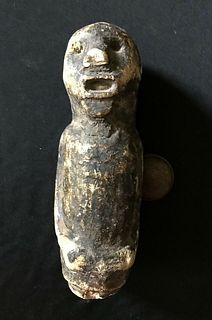Inca Bichrome Camelid / Llama Stirrup Vessel
Lot 81a
About Seller
Artemis Gallery
686 S Taylor Ave, Ste 106
Louisville, CO 80027
United States
Selling antiquities, ancient and ethnographic art online since 1993, Artemis Gallery specializes in Classical Antiquities (Egyptian, Greek, Roman, Near Eastern), Asian, Pre-Columbian, African / Tribal / Oceanographic art. Our extensive inventory includes pottery, stone, metal, wood, glass and textil...Read more
Categories
Estimate:
$3,000 - $4,500
Absentee vs Live bid
Two ways to bid:
- Leave a max absentee bid and the platform will bid on your behalf up to your maximum bid during the live auction.
- Bid live during the auction and your bids will be submitted real-time to the auctioneer.
Bid Increments
| Price | Bid Increment |
|---|---|
| $0 | $25 |
| $300 | $50 |
| $1,000 | $100 |
| $2,000 | $250 |
| $5,000 | $500 |
| $10,000 | $1,000 |
| $20,000 | $2,500 |
| $50,000 | $5,000 |
| $100,000 | $10,000 |
| $200,000 | $20,000 |
About Auction
By Artemis Gallery
Jul 1, 2021
Set Reminder
2021-07-01 10:00:00
2021-07-01 10:00:00
America/New_York
Bidsquare
Bidsquare : Antiquities | Asian | Ethnographic Art
https://www.bidsquare.com/auctions/artemis-gallery/antiquities-asian-ethnographic-art-7148
Featuring classical antiquities, ancient and ethnographic art from cultures encompassing the globe. Egyptian, Greek, Roman, Near Eastern, Asian, Pre-Columbian, Native American, African / Tribal, Oceanic, Spanish Colonial, Russian, Fossils, Fine Art, more! All legally acquired, legal to sell. Artemis Gallery info@artemisgallery.com
Featuring classical antiquities, ancient and ethnographic art from cultures encompassing the globe. Egyptian, Greek, Roman, Near Eastern, Asian, Pre-Columbian, Native American, African / Tribal, Oceanic, Spanish Colonial, Russian, Fossils, Fine Art, more! All legally acquired, legal to sell. Artemis Gallery info@artemisgallery.com
- Lot Description
Pre-Columbian, North Coast Peru, Inca, ca. 1200 to 1500 CE. A finely crafted ceramic stirrup vessel representing a camelid, most likely a llama, finished in white slip with black painted details. A stirrup handle emerges from the back and rises to a rimmed spout. The painted checkered flanks are representative of woven fabric, capturing the patterns of a draped cloth, hinting at the Inca's rich textile traditions. Stirrup spout vessels were the predominant ceramic form throughout the Pre-Columbian Peruvian region from the earliest cultures beginning around 1000 BCE until the conquest of the Inca in the 15th century. These vessels were often used for ritualistic purposes and buried with the deceased. The iconography of the llama is significant, for the Inca did not have horses or cows, so llamas provided the Inca with wool, food, and a way to transport goods. Although they were not worshiped, llamas were integral to their folklore and the Inca believed that llamas could talk. The side tongue sticking out sideways is perhaps a playful reminder of the llama's loquacious past. Size: 7.25" L x 2.5" W x 8" H (18.4 cm x 6.4 cm x 20.3 cm)
Provenance: private Hawaii, USA collection; ex-K. Klassen collection, Seattle, Washington, USA, acquired by 1990
All items legal to buy/sell under U.S. Statute covering cultural patrimony Code 2600, CHAPTER 14, and are guaranteed to be as described or your money back.
A Certificate of Authenticity will accompany all winning bids.
We ship worldwide and handle all shipping in-house for your convenience.
#109000Old inventory label on the base. Minor nicks to rim and surface wear commensurate with age. Nice painted details and intact!Condition
- Shipping Info
-
All shipping is handled in-house for your convenience. Your invoice from Artemis Gallery will include shipping calculation instructions. If in doubt, please inquire BEFORE bidding for estimated shipping costs for individual items.
-
- Buyer's Premium



 EUR
EUR CAD
CAD AUD
AUD GBP
GBP MXN
MXN HKD
HKD CNY
CNY MYR
MYR SEK
SEK SGD
SGD CHF
CHF THB
THB
















